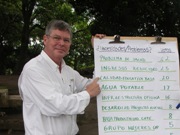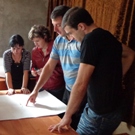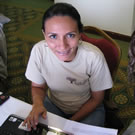Chapter 3 Summary of my complementary, 50 page e-book: Four Powerful 1st Steps in Designing & Funding Non Profit Projects.
Chapter 3. Project Design Using Evidence-based Activities
In the last newsletter we looked at how to find potential solutions to challenges discovered during a needs assessment—and then how to develop a project outline complete with programs, project activities and a goal statement. You can read that discussion here.
This week’s newsletter is for determining through scientific research if your initial ideas for activities have shown evidence of having worked to solve your community’s needs and challenges. We’re looking for evidence based best practices.
|
Don’t you want your project to work?
|
|
 |
Investigating if there is a scientific basis that our proposed theory and activities have worked on other projects. Suppose that you are a mother whose children are at risk, and an unknown organization came to you with a plan to help your children. Wouldn’t you want that plan to work?
Suppose that you were a local non profit hoping to improve the lives of your constituents. Wouldn’t you want to be successful?
|
Suppose that you are a donor hoping that your donations will fulfill some need. Wouldn’t you want your donations to have an impact?
“Rigorous evaluations typically find that around 75% of programs or practices that are intended to help people have little or no effect” according to Ron Haskins of the Brookings Institution in his New York Times article “Social Programs That Work.” He suggests that av emerging “evidence-based movement separates the wheat from the chaff.” He feels that this “evidence-based initiative has charted a new path that could reduce poverty and increase economic opportunity for the disadvantaged.”
| Will your theory of a solution work? | |
 |
Today it is acknowledged that many non profit programs haven’t kept up with increasing need. One of the very simple reasons is that organizations are copying what other organizations are doing without stopping to check to see if their programs are working and having any lasting impact.
|
There is an extraordinarily simple solution to this and that is to do a bit of research to see if any studies have been done about the effectiveness of your proposed activities. For those of us who are human beings, this can be quite challenging. We think something will work, we fall in love with the idea, we become obsessed with the idea, and we won’t let go of it. But what if 100 other organizations have tried the idea, evaluators have evaluated the outcomes, and unfortunately came to the conclusion that the intervention/activity did not work to address a specific community challenge.
| Research whether there is a basis in scientific evidence that an activity works | |
 |
So, at this early stage, before you fall in love with your idea, you have the opportunity to research whether there is a basis in scientific evidence that it works.
Both universities and forward thinking organizations monitor projects in an effort to determine if they are achieving their desired impact. The results of many of those studies are available online.
|
So in this week’s assignment, we will take our three favorite project activities, and search the Internet to see if scientists have found evidence that our chosen activities work to solve the problem statement that we prepared.
Searching for information on your proposed activities is a bit of an art. Right now, this instant, open up a Word document and save it under the name ‘key words.’ Every time that you search for something on the Internet with a set of keywords that perform well for you, add them to your ‘key words’ document and save them. Frequently, you will find in scientific documents a list of keywords (sometimes called tags) which authors used to research their studies. Save those too. Soon, you will have an arsenal of keywords that will make you into an expert of searching for scientific documents.
What is a scientific, peer-reviewed, document?
A cornerstone idea behind science is that investigators don’t let their personal thoughts, feelings and needs become muddled with the results of their investigations. One of the techniques for ensuring that is to share a draft of their study with their scientific peers. If their peers feel that a scientist has not kept an arms length distance in their analysis, they will recommend corrections. This becomes known as a peer-reviewed study. It is these studies that we are looking for.
If you are connected to a university these studies will be easy to find. Universities subscribe to scientific search engines which are programmed to find scientific studies.
If you don’t work for a university you can start by using Google. With a good collection of keywords, Google is tremendously powerful and can lead you to many papers that are freely downloadable online. Make sure that they’re from a reputable university or research institute.
Google Scholar
Google also has a site called Google Scholar which only connects to scientific documents: a gold mine.
These documents will give you an abstract or executive summary that will tell you in one paragraph the results of the study. The body of the study will give you the information on why the activity did or did not work and under what circumstances and what cost. The circumstances are very important because you may discover that your proposed activity may not work in some situations—but will work perfectly in a different situation. Make sure that your proposed activity has shown evidence of having worked in your situation.
What if you find evidence that your proposed activity doesn’t work in your situation? Analyze if this challenge entails a minor modification to the activity (which you may be able to do). Otherwise, search for new activities that will work that you haven’t thought of yet. I use plain English in Google in these situations and have had good luck. For example, for my project I used: “Are urban vegetable gardens a source of food for food banks?” This brought forth a gold mine of information.
Please note:
This is part of the process for developing a project design is for a course I teach called OL 201, Designing and Funding Nonprofit Projects. The first two assignments in 201 include detailed instructions for conducting a live needs assessment, finding specific resources that you will need for conducting the assessment, an example of a completed assessment, and a project concept based upon the results. This third assignment leads you through the process of finding evidence based best practices.
I hope that you enjoyed this. If you have a question don’t hesitate to contact us.
Sincerely,
Tim Magee

